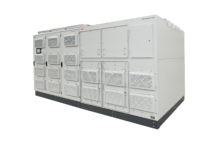In this sponsored post, Enersys claims the battery technology in its UPS can deliver shorter run times and cut running costs by 25% compared with traditional valve regulated lead acid batteries.
this sponsored post, Enersys claims the battery technology in its UPS can deliver shorter run times and cut running costs by 25% compared with traditional valve regulated lead acid batteries.
Changes in the datacentre industry, such as the advent of cloud storage, the shift to colocation companies and the growing trend toward modular, containerised power and an evolution towards shorter runtimes have placed new demands on battery technology.
Today’s batteries must break new ground; batteries must be capable of providing more power at shorter run times and able to operate in higher ambient temperatures, while lasting longer.
Uninterruptable Power Supply (UPS) battery technology is now available to provide datacentres with an advantage in today’s mission critical applications. Absorbed Glass Mat (AGM) batteries featuring advanced Thin Plate Pure Lead (TPPL) technology provide superior performance characteristics and efficiencies compared to traditional Valve Regulated Lead Acid (VRLA) batteries often used in backup power systems.
Runtimes of less than five minutes
DataSafe XE AGM TPPL batteries are capable of delivering high power, short duration runtimes of less than five minutes, even as short as 30 seconds. This marks a significant breakthrough in autonomy times which historically have been standardised at 15-minute runtimes and yields immediate energy savings with increased life expectancy.
Greater power density
In AGM TPPL batteries, thinner plates allow for better electrolyte contact and better active material utilisation compared to standard VRLA batteries. Greater plate density provides more power in the same space or allows for smaller battery installation thus providing space saving benefits.
Rapid recharge capability
The power-dense structure and greater active material utilisation enable AGM TPPL batteries to recharge more rapidly and have higher cycling capability. In addition, providing the charge voltage is properly regulated, they do not require current limitation, which allows for more rapid recharging.
Low float current
The high purity materials in AGM TPPL batteries requires low float current when compared to standard AGM batteries. This results in lower gas emissions, minimal grid corrosion, optimum conductivity and enhanced energy efficiency.
Higher operating temperatures
AGM TPPL battery technology enables users to increase operating temperatures in equipment rooms thus lowering air conditioning energy costs.
Less corrosion, longer life
Most VRLA batteries employ a calcium alloy. Calcium is added to provide additional strength to the grid during the manufacturing process. However, impurities such as calcium additives accelerate the corrosion process and increase the size of the grain leading to accelerated grid growth and higher internal resistance.
Even though positive grid corrosion is always present in VRLA batteries, the very high purity lead used by EnerSys has a lower corrosion rate than lead with alloys. TPPL technology greatly delays corrosion which enhances conductivity, performance and longevity.
Summary: Lower total cost of ownership (TCO)
AGM batteries with TPPL technology deliver high power, short duration runtimes in a power-dense, energy-efficient design. The ability to operate datacenters at higher temperatures together with the lower energy consumption of TPPL batteries can reduce the total cost of ownership up to 25% compared to conventional VRLA batteries.
Visit www.enersys.com for more details.
Click here to see if you qualify for a free subscription to the print magazine, or to renew.
Follow us at @EnergystMedia. For regular bulletins, sign up for the free newsletter.



